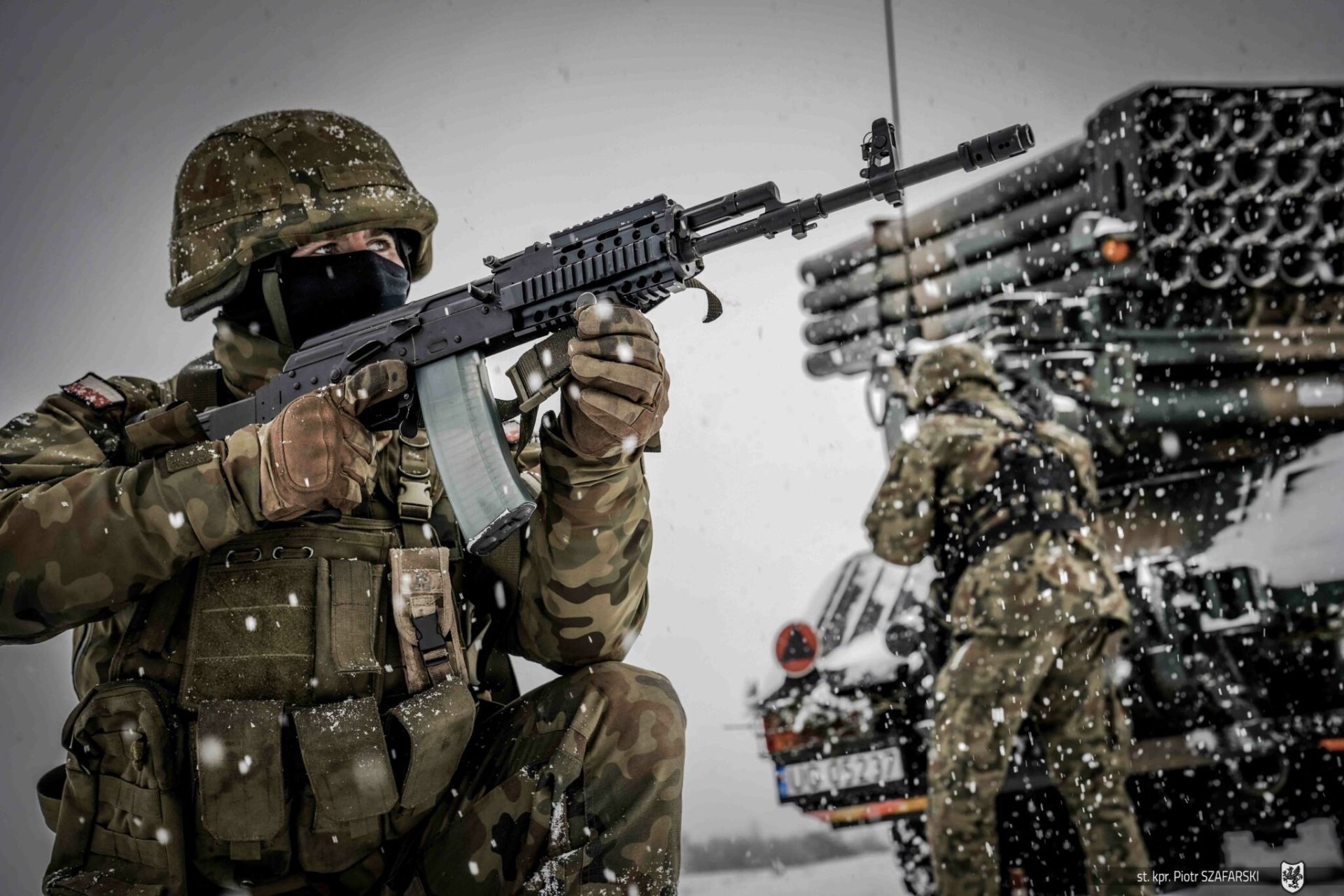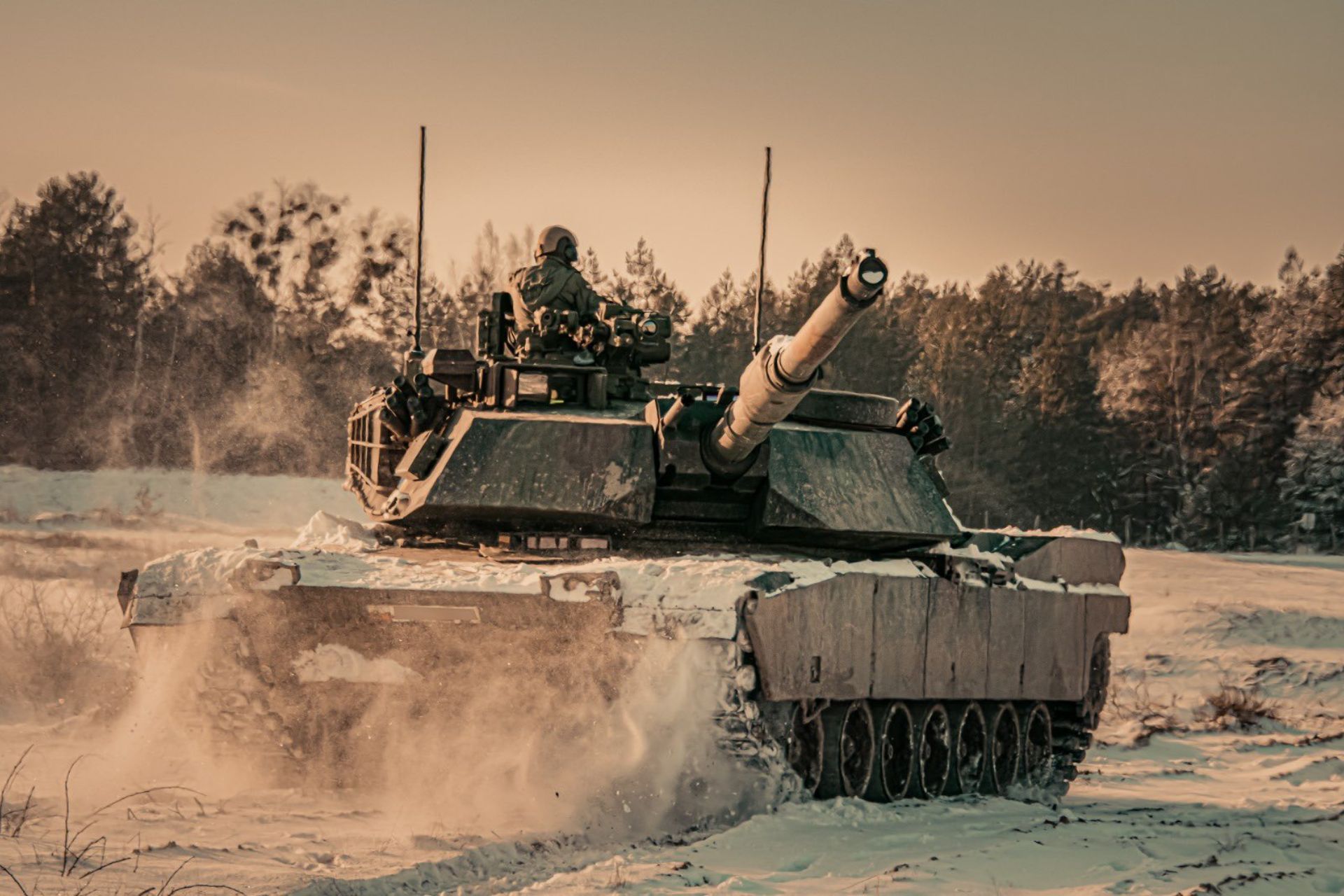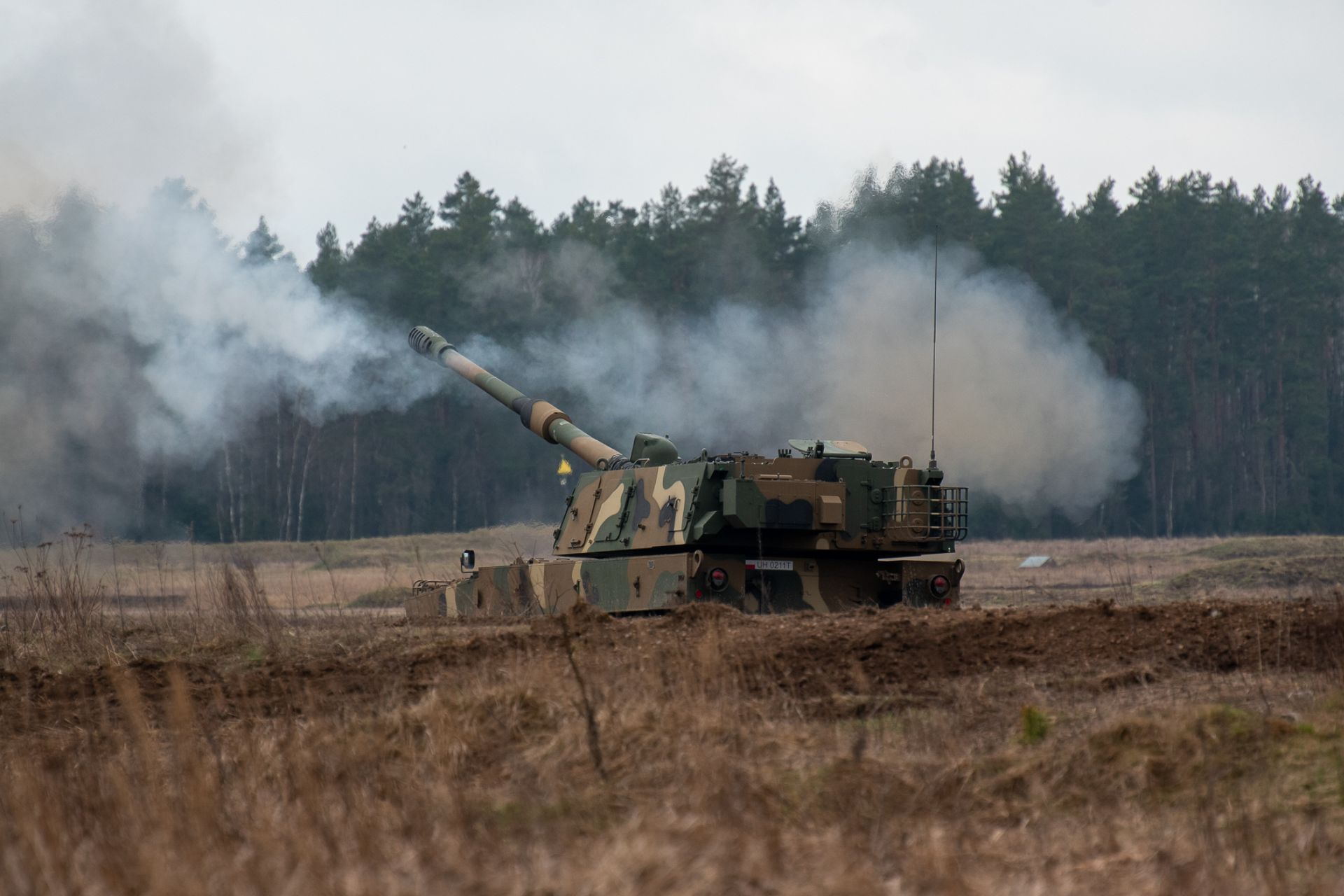Breaking News
FOCUS | NATO Model: framework for Poland's future forces is taking shape.
In recent years, Poland has launched the largest military modernization program in its history. However, not all of the widely publicized announcements have resulted in firm orders. Imminent financial difficulties also cast doubt on these ambitious projects. In July 2024, Deputy Minister of National Defense Paweł Bejda stated that he dreamed of Poland's defense budget increasing to 5% of the country's GDP. According to official statistics, Poland already spends 4% of its GDP on defense, with 3% coming from the Ministry of National Defense's budget and 1% from the Armed Forces Support Fund (FWSZ). In 2023, €6.7 billion was allocated to Technical Modernization Plan (PMT) expenditures and €1.1 billion to construction investments.
Follow Army Recognition on Google News at this link

Polish soldier during drills in 2024 near belarus border (Picture source: Polish MoD)
In 2024, around 150 contracts are expected to be signed. Priorities include JASSM-ER air-launched cruise missiles, Apache AH-64 attack helicopters, multi-role and support helicopters, F-16 aircraft modernization, additional K2 tanks with ammunition, Pilica air defense systems, unmanned reconnaissance and strike systems, satellite terminals, light reconnaissance vehicles under the Kleszcz program, and light radios. The implementation of air defense programs such as Wisła, Narew, Mała Narew, and Pilica+ must be accelerated. Another priority is to create satellite capabilities from scratch; the Satellite Operations Center is expected to reach full operational capability in 2024. The cyber defense forces, currently numbering around 6,500 personnel (including civilians), are also being expanded.
As for the aforementioned FWSZ, it is an additional instrument for financing the armed forces, outside the Ministry of National Defense's budget. This fund is managed by the Bank Gospodarstwa Krajowego, established by the National Defense Act of March 2022, replacing the Armed Forces Modernization Fund (FMSZ). As noted by Tomasz Dmitruk, the financial plan of the FWSZ is classified, but it is estimated to have been funded with €7.3 billion in 2023.
Equipment
According to official data, the Polish Armed Forces currently consist of 198,000 soldiers, including 130,000 professional military personnel. Additionally, Poland hosts approximately 16,000 soldiers from allied countries. The army is currently undergoing significant expansion, as Poland is creating a sixth division, a decision announced in November 2023. This unit, called the 8th Infantry Division of the Homeland Army, will have its headquarters in Nowe Miasto nad Pilicą, and its units will be deployed across four voivodeships (provinces). It will be composed of two mechanized brigades, one motorized brigade, and one armored brigade. Furthermore, the 8th Infantry Division will include an artillery brigade, a logistics regiment, an anti-tank regiment, an anti-aircraft regiment, a command battalion, a reconnaissance battalion, and a chemical battalion.
Despite various challenges, the expansion of the Territorial Defense Forces (TDF) continues, which currently include around 35,000 soldiers. This year, they are expected to reach 20 brigades, including two brigades designated as border protection units. Within the operational forces, Poland is continuing to form a fifth division (the 1st Legion Infantry Division) with four brigades, a move that is controversial because existing formations are already facing equipment and personnel shortages. The formation of the 18th Mechanized Division in 2018 was difficult due to the transfer of existing units.
These measures are in line with the previous government's plan to create a 300,000-strong army. The current government is less enthusiastic about creating a 300,000-strong army, as are many experts who believe the army is already too large given the limitations in appropriate equipment. The army also lacks proper command and control (C2) systems, training, material reserves, and logistics. Critics draw an analogy to the situation in 1939 when Poland had a numerically large army but low combat effectiveness.
The Polish army is now the largest in Europe and the third largest in NATO (behind the United States and Turkey) in terms of personnel, but it ranks 22nd in terms of spending per soldier. Although Poland is investing significant sums in its armed forces, soldiers face a shortage of personal equipment. Many are forced to use worn-out gear, including old uniforms and helmets. Some soldiers even purchase necessary items themselves, including those used at the border. To address this, Operation Szpej (Equipment) was launched. Under this initiative, new uniforms with effective camouflage, new bulletproof vests, composite helmets, Grot rifles, VIS 100 pistols, sights, night vision goggles, gas masks, and filtering protective clothing are to be ordered. The first phase is expected to be completed by December 2024.

Polish troops carrying Grot carbine rifles( Picture source: Fabryka Broni Radom)
Armored Units
In recent years, Poland has made significant investments in its armored forces in response to the growing threat from Russia and the previous government's decision to donate dozens of main battle tanks (MBTs) to Ukraine. Between 250 and 300 T-72M1/M1R, 14 Leopard 2A4, and up to 80 PT-91 Twardy tanks were donated to Ukraine. Poland has ordered 180 South Korean K2 tanks and 366 Abrams tanks (116 ex-USMC M1A1 FEP and 250 new M1A2 SEPv3 tanks, along with 26 M88A2 recovery vehicles and 17 M1074 bridge layers). The Abrams and K2 tanks are expected to soon become the country's main MBTs, as all Soviet-era tanks are to be retired as soon as possible. The Leopard 2 tanks (2A4, 2A5, 2PL – 247 in total by 2026) are expected to meet the same fate, though much later, with some of these tanks likely being placed in reserve. The overall framework agreement covers the acquisition of a total of 1,366 main battle tanks. Despite industrial issues and significant delays, a modernization program for Leopard 2 tanks to the Leopard 2PL standard is underway. The current plan is for the last modernized Leopard 2s to be delivered to the army by 2027, seven years later than originally planned.
As for the K2 tanks, deliveries are expected to be completed by 2025. The contract value, including training and logistics packages, amounts to €3 billion. However, in July 2024, it was revealed that negotiations were underway for a second contract involving 180 tanks, which is expected to be signed in September 2024. Some of these tanks are to be produced in Poland. All the M1A1FEP tanks have already been delivered, while the SEPv3 tanks are expected to be delivered in 2025-2026. The contract for the SEPv3 tanks is worth approximately €4.66 billion, including training, logistical support, and ammunition.
In reality, the future shape of Poland's armored units remains a mystery. Besides the uncertainties surrounding the Leopard 2 tanks, Poland has yet to finalize the details of its planned local production of K2 tanks from South Korea. The final configuration of the K2PL variant is also unknown. Poland's potential involvement in the K3 tank project, which is expected to feature a 130mm cannon and an unmanned turret, also remains uncertain, although Poland has been invited to participate in this program. According to initial plans, at least 500 K2PL tanks are to be produced by the Military Automotive Works (WZM) in Poznań. Other companies, including Hyundai Rotem's initial partner in Poland, H. Cegielski-Poznań (HCP), will also be involved in the process.

At the training ground in Nowa Dęba, soldiers of
1st 1st Warsaw Armored Brigade , with the use of the experience and knowledge of US soldiers, conducted training on Abrams tanks (Picture source: X.com/@Poland_MOD)
Artillery
Due to the donation of some of its locally designed and manufactured 155mm Krab self-propelled howitzers (SPH) by HSW, as well as plans for modernization, Poland made the controversial decision to purchase K9 SPHs from South Korea. So far, 72 of the 218 ordered K9A1 units have been delivered. Between 2026 and 2027, 146 K9A2 units are expected to arrive. Simultaneously, the Polish army continues to receive additional Krab howitzers, with a total order of 170. The Polish defense industry hopes that further orders for Krab will be placed.
Poland has already received 18 of the 20 M142 HIMARS units and 30 of the 290 modules for the K239 Chunmoo launchers (the latter as part of the Homar-K project). These will be based on the Polish Jelcz chassis and will be equipped with the WB Group Topaz Polish automated fire control and battle management system. An agreement worth €4.36 billion was signed in early November 2022 between the Polish Armament Agency and Hanwha Aerospace. Under the current contract, 218 systems are to be delivered, which also includes training and logistics. Poland will also receive "several thousand" missiles of two types: 239mm (with a range of 80 km) and 290mm (with a range of 290 km). Deliveries are scheduled between 2023 and 2029.
The Homar-K launchers will significantly enhance Poland's artillery capabilities. The current artillery systems of the Polish army, such as the 155mm Krab tactical ballistic missiles and the WR-40 Langusta wheeled rocket launchers, do not use guided munitions and have a range of only around 40 km (Poland's 9K79 Tochka tactical ballistic missiles were retired from service in 2005). To fully exploit the long-range strike capabilities of the K239 Chunmoo, Poland will either need to develop its own reconnaissance and targeting capabilities or cooperate closely with its allies.

K9 thunder- self proppelled howitzer- crew practicing at the training ground in Bemowo Piskie, in March 2023. (Picture source: X.com/@Poland_MOD)
Aviation
Poland has received 12 KAI FA-50 Block 10 light combat training aircraft (known as KA-50GF in Polish service); this variant has been deployed at the 23rd Tactical Air Base in Minsk Mazowiecki, which also operates MiG-29s. This is a temporary solution until Poland can put the better-armed and better-equipped FA-50PL into service. This purchase, one of the most controversial among recent orders from South Korea, is intended to allow the Polish Air Force to gradually phase out its Soviet-era MiG-29s and Su-22s. Operationally, the FA-50s will be used for training and to replace the F-16C/D in certain missions, primarily peacetime air policing. A total of 48 jets are to be purchased, including 12 FA-50GF and 36 FA-50 Block 20 (known as FA-50PL in Polish service). The first batch of 12 FA-50GF is expected to be upgraded to the FA-50PL standard, equipped with AESA radar and armed with AIM-9X Sidewinder and AIM-120 AMRAAM missiles. This is the largest export order ever for KAI. The deliveries and the upgrade of the GFs are scheduled between 2025 and 2028.
Poland is awaiting the delivery of 36 F-35A aircraft, ordered in January 2020 for $4.6 billion. Deliveries are expected between 2026 and 2030. In the meantime, Poland has ordered two second-hand Saab 340 AEW early warning aircraft, formerly from the United Arab Emirates, equipped with PS-890 ERIEYE airborne radars. Although these aircraft are used, they represent a significant improvement in capabilities as they are the first of their kind to serve in the Polish Air Force. While this is good news, there is some disappointment in Poland, as many had hoped the government would procure more modern and advanced systems. Although the Ministry of National Defense assures that this is only a temporary solution, many commentators fear that the Saab 340 will be the only aircraft of this category that Poland acquires in the coming years.
Poland is expected to acquire more combat aircraft. According to the previous government's plans, the Polish Air Force aims to create two additional combat squadrons. The acquisition of the Boeing F-15EX Eagle II has already been discussed, but the acquisition of the F-16C/D Block 72 is also a possibility. Leonardo, on the other hand, is promoting the Eurofighter Typhoon. New F-16s could be used alongside the F-16C/D Block 52+, which will likely be upgraded to the Block 72 standard in the coming years. The purchase of additional F-16s would therefore not pose logistical issues.
Poland has also modernized its facilities with various drones. The list includes 24 Bayraktar TB2 drones, with the fourth and final batch delivered to the 12th Drone Base in Mirosławiec in May 2024. Poland has also leased a set of MQ-9A Reapers and has purchased at least 168 FlyEye drones, with a need for 400 of these by 2035. Regarding helicopters, Poland has received six of the eight S-70i helicopters ordered for special forces, three of the four AW101 helicopters for the navy (for SAR and ASW missions), and four of the 32 AW149 helicopters for the air cavalry. The AH-64E Apache attack helicopters have not yet been ordered. Poland also plans to purchase 24 new training helicopters.

Polish Planes flying alongside Irish F-35 during Air policy mission ( Picture source: Polish MOD)
Future Challenges
One of the main challenges facing Poland is financial constraints. The country has adopted overly ambitious modernization plans, driven partly by internal political calculations and attempts to gain popularity with voters. In reality, however, there won't be enough funds to finance all these projects. Delays in some projects and the lack of executive agreements perfectly illustrate this problem. Poland not only needs to find the money to purchase specific weapons but also to implement and maintain them for many years.
"The previous Minister of Defense, Mr. Błaszczak, did not secure funding for infrastructure, for example," highlighted Deputy Minister Bejda. "These are crucial elements that accompany orders and must also be funded and built." The current government estimates that the financial shortfall from the previous government for ongoing projects amounts to around €14 billion.
In June 2024, the European Commission classified Poland among the 12 countries with excessive deficits (more than 3% of GDP or public debt exceeding 60% of GDP). The Polish government explains this situation by the increase in defense spending. Although this is considered a mitigating circumstance by Brussels, according to EU methodology, military expenditures are accounted for not at the time of payment but at the time of delivery. According to the European Commission's report, Poland's defense spending is expected to double over the next four years.
The government has adopted a deficit reduction plan aimed at bringing the deficit down to 4.1% of GDP by 2025. This means that Poland will most likely have to cut domestic spending and revise its defense plans.


























